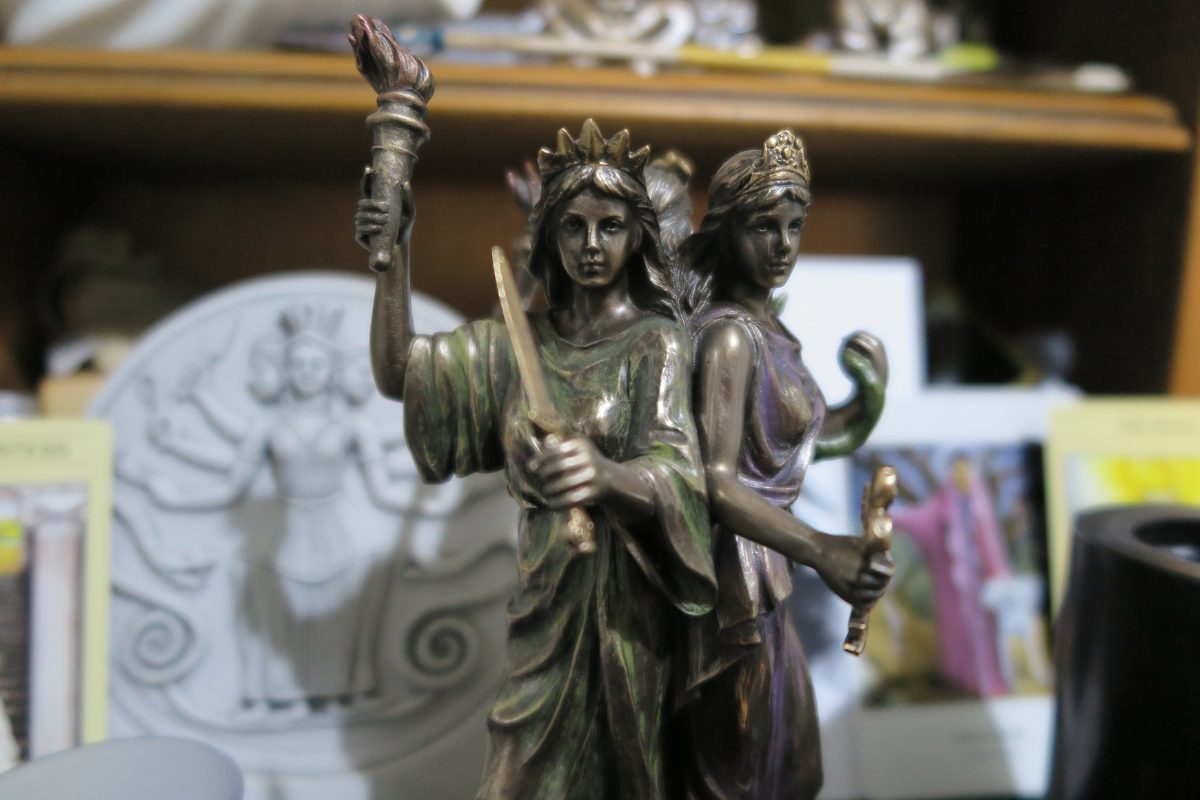I’m dedicating the month of October to the goddess Hekate and sharing a series of blog entries about her. Who is Hekate? What are her functions? How do we worship her?
In Hekate: An introduction to the Goddess of the Crossroads, I offered a summary of what I think are some of the most important things to know about Hekate as you get to know her. How to worship Hekate, goddess of boundaries and witchcraft summarises popular approaches to the worship and magick of Hekate. This feature explores devotional practices dedicated to Hekate, the Deipnon and Noumenia in particular, and I share my approach to these.
A shrine to Hekate
I have a shrine dedicated to Hekate. It is a shelf on an IKEA BILLY bookcase and contains the following:
- A statue of triple-form Hekate in a bronze finish (shown below)
- The Roman Hecate plaque from Sacred Source (shown below)
- A framed print of Iberian Hecate by Medusa Dollmaker
- A print of the lunar phases by Australian artist Lauren Merrick of To The Trees, a gift I received years ago
- A black pillar candle
- A small, metal, decorative lantern with a tealight
- A couple of decorative keys, gifts from a good friend who is a priestess of Hekate
- A small, vintage, ruby wine glass, a gift from my husband that is perfect for libations
- A ceramic trinket box that contains crystals, jewellery, and other small items
- A blend of herbs for burning
- The Mythic Tarot, which I have dedicated to Hekate
- Books on Hekate
These items are always on Hekate’s shrine, and I add to them as I come across something special: the Deipnon, the Noumenia, and Agathos Daimon.
Hekate’s shrine is a visible part of my room. I don’t spend a significant amount of time in front of the shrine every day, but I acknowledge her every day, and hold a monthly observance.

A three-day household observance
Following a lunisolar calendar where the new moon marked the first day of the month, ancient Greeks held three days of rituals to mark the transition from one month to the next. On the liminal night between the old and new months, Greeks observed Hekate’s Deipnon during the dark moon. The Noumenia took place on the first day of the month when the first sliver of the moon was visible. Agathos Daimon took place on the second day of the lunar month.
The Deipnon
Deipnon means the evening meal. Hekate’s Deipnon was observed during the dark moon, the liminal night between the old month and the new, marking the transition. The Deipnon consists of three parts: purification, expiation, and a meal.
Expiation is atonement. If the household felt polluted or needed to make amends with Hekate, they sacrificed a dog. Before killing it, the household members touched the dog, transmitting their bad deeds onto it, using it as a scapegoat. The head of the family read the entrails to ensure Hekate accepted the sacrifice.
Purification is the removal of physical and energetic dirt and making a space ceremonially clean. It’s like spring cleaning every month. The Greeks collected leftovers from previous rituals and smoked the house using a baked clay censer.
Athenians believed that the restless dead roamed during the night hours of the Deipnon. The remains of the sacrificed dog, the purification leftovers, and clay censer were offered to Hekate and the restless dead along with a meal. The meal offering was to honour Hekate and appease the souls. Offerings were left at a crossroads, but people didn’t like to leave the house these nights. Many had shrines to Hekate outside their homes where the meeting of the street and doorway created a crossroads. They left the offerings and did not look back for fear of angering the spirits and being driven mad by them.
The Noumenia
The Noumenia was a day of relaxation, feasting, and offerings to the Hellenic household gods, including Hekate. Offerings included frankincense, flowers, barley cakes, and wine.
Think of the Deipnon and Noumenia together like New Year’s; out with the old, in with the new. You’ve cleaned and purified your home and yourself during the Deipnon, and, now with the Noumenia, you’re ready for a fresh start.
The Agathos Daimon
Sometimes depicted as a serpent, the Agathos Daimon is the household’s noble or good, protective companion spirit that brings good fortune and security. The household made offerings to the Agathos Daimon to ensure good luck, health, and wealth.

A modern adaptation
I observe something that resembles a combined Deipnon and Noumenia. I collect the leftovers throughout the month—matches, incense sticks and ashes, wax—and place these in a paper bag that I keep in a drawer of the vintage wooden cabinet I use as an altar. During the dark moon, I clean my altar and shrines and perform my ritual for Hekate.
Before I begin, I wash my hands and mouth in a ritual cleansing. I take a moment to ground and centre. First, I light the black pillar and call on Hekate by reciting my adaptation of the Orphic Hymn. I make my offerings, which include the paper bag of leftovers and food. Food offerings may be raw eggs, garlic, onion, barley, figs, olives, olive oil, honey, and red wine. Sometimes I bake cakes or make rice pudding. I thank Hekate, speak to her, and meditate on her mysteries. I may petition her if I need something. Using the Mythic Tarot, I draw a card to receive a message from Hekate. Then I thank Hekate, but I don’t bid her farewell because I have a shrine to her and always feel her presence. I snuff the candle and leave the food offerings at her shrine for the night.
In antiquity, it was customary to leave offerings for Hekate at crossroads. Food was eaten by animals or the poor. It’s not clear what happened to the other leftovers. I suspect it would stay there indefinitely if I placed offerings at the end of my driveway or any other crossroads. It would probably also annoy my husband and pique my nosy neighbour’s curiosity. So, my paper bag of leftovers ends up in the rubbish and food offerings go into our compost bin. If you leave your offerings outside, I encourage you to leave only the organic items and use a compostable plate.
My monthly ritual to Hekate is more of a devotional act than a rite of purification or an offering to appease the restless dead. I smoke myself and my space regular for purification. And, while I have a regular ancestral practice, and I honour the spirits of the land on which I live, I don’t generally worry about grumpy, wandering souls.
Also, I don’t follow a lunar calendar; I follow the Gregorian solar dating system that most of us do. I get the fresh start feeling on the first day of the month and not during the new moon. I’ve experimented with performing the Deipnon on the last day of the month and the Noumenia on the first. Although this is more in keeping with the spirit of the ancient observances, it didn’t work for me. Hekate’s lunar associations are powerful. It feels right to perform the Deipnon and Noumenia according to the lunar calendar. Devotees have been performing these rituals on these nights, on and off, for two thousand years. There’s power in that, and there’s community.
More ideas
There are many ways to adapt the traditional forms of these rituals for modern life. Cleaning and meal-offering remain common ritual elements. Here are some other ideas:
Learn about Hekate. Read a good book or watch a video about her and deepen your knowledge of this fascinating goddess.
Tackle a cleaning project. Clean out the refrigerator or pantry, de-clutter a space, or go through your wardrobe.
Honour your ancestors. Visit the cemetery, set up an ancestral shrine, learn more about your lineage, and perhaps even the ancient pagan traditions of your ancestors.
Volunteer or donate. Because the poor ate offerings to Hekate, some modern practitioners see volunteering in a soup kitchen or donating to a food bank to be in the spirit of the meal offering. Hekate’s liminality also makes her a popular goddess among marginalised people, so you could also donate to an organisation that supports immigration, women’s rights, or LGBTIQ+ rights. Her association with dogs makes animal charities another good choice.
Create something for Hekate. Write a poem, make a drawing, a piece of jewellery, a ritual object, or create a playlist for Hekate.
Spend time with Hekate. You don’t need an elaborate shrine, complicated ritual, or a feast for food offerings. A candle and an offering of fresh water can be enough. Sit with Hekate, talk to her, and listen. Your time with Hekate is yours.


This really felt like the how-to page for worshiping Hecate. You went through specific rituals.
Thank you! I hope that readers find it useful.
Thanks for the guide, I felt quite lost and overwhelmed with all the information.
I very much feel called to Hecate (and to Cerridwen, though to a bit lesser extent). I got a book about Hecate last night and fell asleep reading it. In my dreams, I was tapped three times on my right shoulder. Unfortunately I found out about Deipnon today, but I’ll be prepared to celebrate next time.
Thanks for reading and commenting, Ann. I’m glad you found the article helpful.
Thank you for your insight on Mother Hecate, i started my research on her when readinf your blog. I did my first Deipnon ritual this past week and i felt a stronger energy as if a prescence though i did differently i left the offering by my front door since its not safe outside. Since ive read she protects at a threshold i prayed and im dedicating a space for her there but not as her main alter. I did the same steps and felt a difference in energy